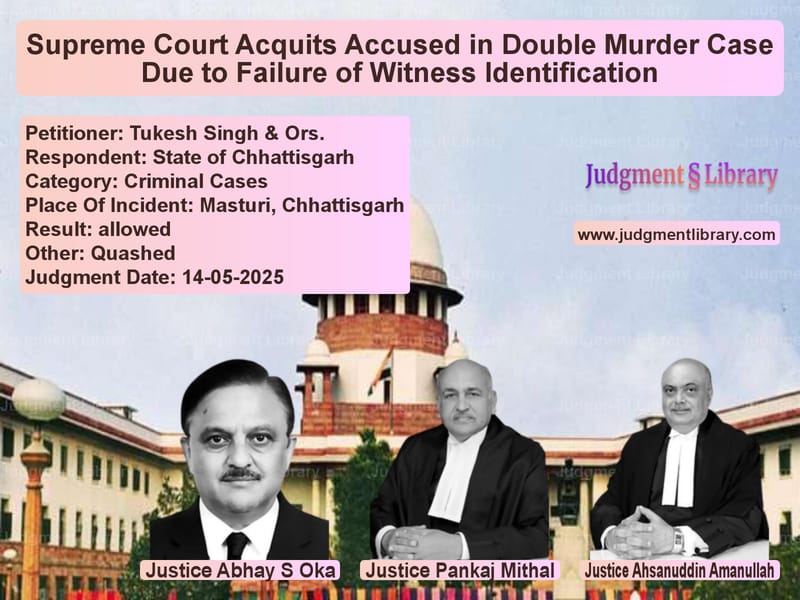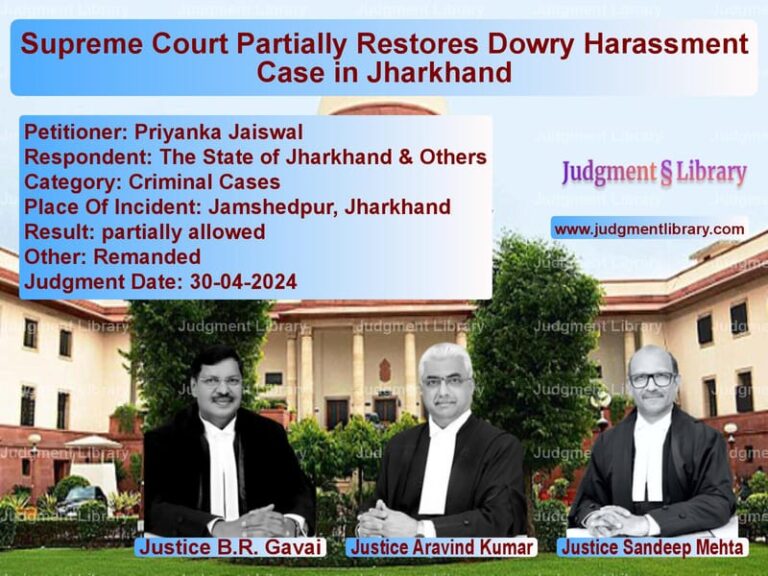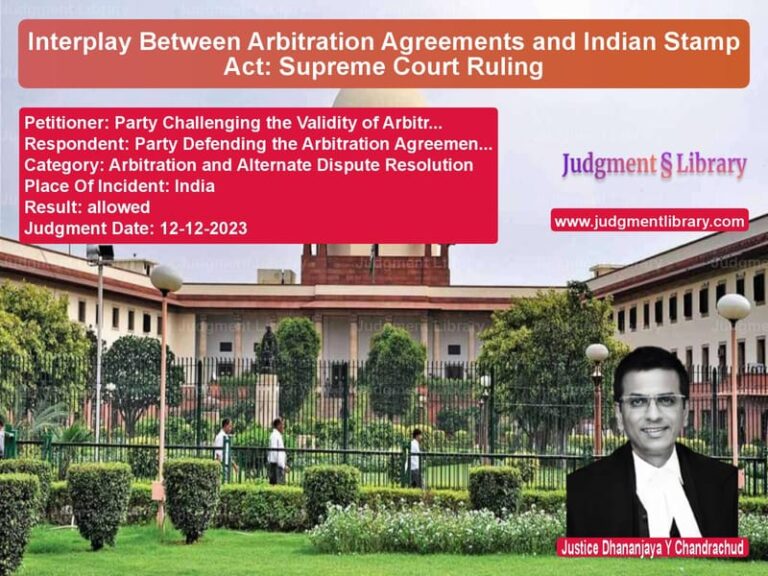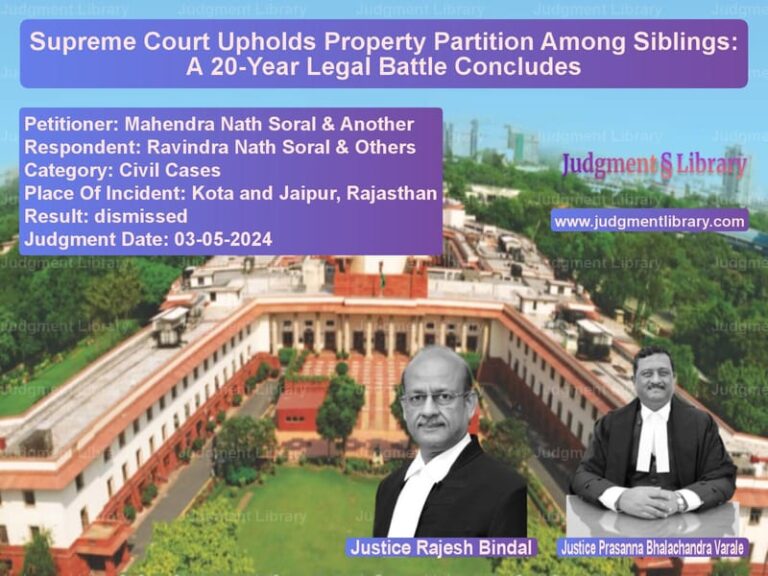Supreme Court Acquits Accused in Double Murder Case Due to Failure of Witness Identification
In a significant criminal law judgment, the Supreme Court of India has acquitted eight individuals who were previously convicted and sentenced to life imprisonment for a double murder that occurred in Chhattisgarh in 2001. The Court, after a meticulous examination of the evidence, found that the prosecution failed to prove the guilt of the accused beyond a reasonable doubt, primarily due to the failure of eyewitnesses to identify the accused in court and numerous material contradictions in their testimonies.
The case, which spanned over two decades, involved a violent incident on March 24, 2001, in Masturi, where two individuals, Manrakhan Singh and Narayan Singh, were allegedly murdered. The prosecution’s case rested heavily on the accounts of several injured eyewitnesses, all of whom were related to the deceased. The Trial Court and later the High Court had convicted the accused, relying on this eyewitness testimony.
The Legal Battle Begins
The appellants, through their learned senior counsel, mounted a multi-pronged challenge to their convictions. They argued that there was a counter-case registered based on an FIR filed by one of the appellants, Tukesh Singh, which alleged that the prosecution witnesses were the aggressors. The defense contended that the failure to try this cross-case alongside the main case caused serious prejudice to the accused. The learned senior counsel submitted that “the counter case (Criminal Case No.79 of 2001) registered based on the said FIR ought to have been tried with the case subject matter of these appeals. Therefore, prejudice has been caused to the appellants/accused.” He relied on several Supreme Court decisions, including Sudhir & Ors. v. State of M.P., Kuldeep Yadav & Ors. v. State of Bihar, and Nand Lal & Ors. v. State of Chhattisgarh, to bolster this argument.
Another crucial point raised by the defense was the failure of the prosecution to explain the injuries sustained by the accused. This, they argued, suggested that the complainant’s party was the actual aggressor. The defense also highlighted a significant delay of five and a half hours in lodging the FIR, despite the police station being merely two to three furlongs away and two police constables arriving at the spot immediately after the incident. Furthermore, the statements of key witnesses, PW-4 (Judawan Singh) and PW-11 (Rajendra Singh), were recorded after an unexplained delay.
The defense strongly challenged the reliability of the eyewitnesses. They pointed out that the eyewitnesses—PW-1 (Shivraj Singh), PW-3 (Virendra Singh), PW-4 (Judawan Singh), PW-5 (Visheshwar Singh Thakur), and PW-8 (Rakesh Singh Thakur)—were all closely related to each other and the deceased, making them “interested witnesses.” Their accounts of the incident, the defense argued, differed in material particulars, and they made omnibus statements without attributing specific roles to individual accused. The defense also noted that three independent eyewitnesses—PW-13 (Dilip Singh), PW-14 (Shiv Kumar Dubey), and PW-15 (Ishwari Srivas)—did not support the prosecution’s version. The defense witness, Dr. Smt Subhadra Painkra (DW-1), testified that one of the accused, Ramesh Singh, was hospitalized from March 23 to March 24, 2001, which contradicted the prosecution’s timeline.
Given these frailties in the prosecution’s case, the learned senior counsel submitted that the prosecution had not met the standard of proof beyond a reasonable doubt. He argued that even if the court were to find some evidence of involvement, the case would at most fall under an exception to Section 300 of the IPC, attracting the offense under the second part of Section 304 (culpable homicide not amounting to murder). Given that the appellants had already undergone sentences between 9 and 14 years before being released on bail by the Supreme Court, he pleaded for their acquittal or, alternatively, for their release based on the punishment already undergone.
The State’s Defense
The learned Deputy Advocate General for the State of Chhattisgarh defended the concurrent findings of the Trial Court and the High Court. He argued that the injuries sustained by the four accused persons were “very minor” and that there was no evidence to show that the complainant’s side was the aggressor or had assaulted the accused. He maintained that no prejudice was caused to the accused by the separate trial of the cross-case. The State relied heavily on the testimony of the injured witnesses, asserting that their evidence had been rightly believed by the courts below. He submitted that the “testimony of injured witnesses has been rightly believed by both the Courts.” He further argued that the “minor contradictions and omissions brought to light in the cross-examination of the eyewitnesses are not sufficient to discard their testimony.” The State, therefore, urged the Supreme Court not to interfere with the convictions.
The Supreme Court’s Scrutiny
The Supreme Court bench, comprising Justices Abhay S. Oka, Pankaj Mithal, and Ahsanuddin Amanullah, embarked on a detailed analysis of the evidence, particularly focusing on the testimonies of the five injured eyewitnesses. The Court’s examination revealed fatal flaws in the prosecution’s case.
The Court began with the evidence of PW-1 (Shivraj Singh), the father of one of the deceased. The Court noted that PW-1 knew only four of the nine accused and stated in his testimony that he did not know whether the rest were involved. Crucially, the Court observed that “he was not called upon to identify any of the accused present in the Court, and therefore, he did not depose that the accused present in the Court were the same accused he had seen committing the offence.” His testimony also suffered from material omissions, as he accepted that several key details he mentioned in court were not found in his police statement.
The evidence of PW-3 (Virendra Singh), the son of PW-1, was next. While he named several accused and ascribed specific roles to them in his examination-in-chief, the Court found that “he was not called upon to identify the accused in the Court, as in the examination-in-chief, he was not called upon to do so.” His testimony was also riddled with significant omissions regarding the roles of various accused, which he had failed to mention in his police statement. The Court also noted the ambiguity surrounding when his complete statement was recorded, as he admitted that his initial statement on March 28, 2001, was incomplete.
The Court then examined PW-4 (Judawan Singh), whose statement was recorded a staggering twenty-one days after the incident. The Court pointed out that “even this witness did not identify any accused in the Court by ascribing them a specific role.” He merely stated he knew all the accused and named two. His cross-examination also revealed vital omissions, such as failing to tell the police that a specific accused had assaulted him on the head.
PW-5 (Visheshwar Singh Thakur) suffered from similar infirmities. His statement was also recorded belatedly on April 14, 2001, and the Court noted that “to this witness, the accused were not shown in the Court for establishing their identity.” He, too, only stated that he knew all the accused and named two. In his cross-examination, he admitted that only two accused participated in the assault on one of the deceased, contradicting the broader prosecution narrative.
Finally, the Court looked at the testimony of PW-8 (Rakesh Singh Thakur), the complainant who lodged the FIR. The Court found that “even in the case of this witness, he has not identified the accused in the Court in his examination-in-chief.” In cross-examination, he stated he knew two of the accused who were present in court and the “other accused,” but he did not individually identify them. His testimony also contained significant omissions regarding the roles of specific accused.
The Core Legal Principle
After dissecting the evidence of each eyewitness, the Supreme Court laid down a fundamental principle of criminal jurisprudence concerning the identification of accused persons by eyewitnesses. The Court explained two scenarios. First, where the eyewitness knew the accused before the incident. Second, where the eyewitness did not know the accused beforehand, necessitating a Test Identification Parade if the evidence is recorded years later.
The Court then delivered a crucial legal pronouncement that became the cornerstone of its judgment: “Identification of the accused sitting in the Court by the eyewitness is of utmost importance. For example, if an eyewitness states in his deposition that ‘he had seen A, B and C killing X and he knew A, B and C’. Such a statement in the examination-in-chief is not sufficient to link the same to the accused. The eyewitness must identify the accused A, B and C in the Court. Unless this is done, the prosecution cannot establish that the accused are the same persons who are named by the eyewitness in his deposition.”
The Court elaborated further with an example: “If an eyewitness states that ‘he had seen one accused assaulting the deceased with a sword, another accused assaulting the deceased with a stick and another accused holding the deceased to enable other accused to assault the deceased.’ In such a case, the eyewitness must identify the accused in the open Court who, according to him, had assaulted the accused with a stick, who had assaulted the deceased with a sword and who was holding the deceased. Unless the eyewitnesses identify the accused present in the Court, it cannot be said that, based on the testimony of the eyewitnesses, the guilt of the accused has been proved.”
The Fatal Flaw and the Verdict
Applying this principle to the case at hand, the Supreme Court found a fatal flaw. It held: “In the present case, in case of two eyewitnesses, in the cross-examination, it is brought on record that the accused persons named by them were sitting in the Court. However, they did not identify a particular accused by ascribing him a role. None of the eyewitnesses has specifically identified any of the accused in the Court.”
The Court concluded that “the failure of the eyewitnesses to identify the accused in the court as the accused they had seen committing the crime is fatal to the prosecution’s case.” This failure, combined with the material omissions in the witnesses’ testimonies that amounted to contradictions under the Code of Criminal Procedure, led the Court to hold that the prosecution had not proved its case beyond a reasonable doubt.
The Court also noted that the versions of the eyewitnesses differed and that the appellants had already undergone a substantial period of incarceration—between 9 and 14 years—before being released on bail about twelve years prior to this judgment.
In its final ruling, the Supreme Court stated: “We are, therefore, of the considered opinion that guilt of the accused has not been proved beyond a reasonable doubt.” Consequently, the Court quashed and set aside the judgment of the High Court and acquitted all the appellants of the offenses alleged against them. Their bail bonds were cancelled as a formality following the acquittal.
This judgment serves as a powerful reminder of the foundational principles of criminal law: the presumption of innocence, the prosecution’s burden to prove guilt beyond a reasonable doubt, and the indispensable requirement of reliable and credible evidence, especially when it comes to the critical step of identifying the accused in a court of law. The Supreme Court’s meticulous approach underscores that even in serious cases like murder, procedural safeguards and the integrity of evidence cannot be compromised to secure a conviction.
Petitioner Name: Tukesh Singh & Ors..Respondent Name: State of Chhattisgarh.Judgment By: Justice Abhay S Oka, Justice Pankaj Mithal, Justice Ahsanuddin Amanullah.Place Of Incident: Masturi, Chhattisgarh.Judgment Date: 14-05-2025.Result: allowed.
Don’t miss out on the full details! Download the complete judgment in PDF format below and gain valuable insights instantly!
Download Judgment: tukesh-singh-&-ors.-vs-state-of-chhattisgar-supreme-court-of-india-judgment-dated-14-05-2025.pdf
Directly Download Judgment: Directly download this Judgment
See all petitions in Murder Cases
See all petitions in Attempt to Murder Cases
See all petitions in Bail and Anticipatory Bail
See all petitions in Custodial Deaths and Police Misconduct
See all petitions in Fraud and Forgery
See all petitions in Judgment by Abhay S. Oka
See all petitions in Judgment by Pankaj Mithal
See all petitions in Judgment by Ahsanuddin Amanullah
See all petitions in allowed
See all petitions in Quashed
See all petitions in supreme court of India judgments May 2025
See all petitions in 2025 judgments
See all posts in Criminal Cases Category
See all allowed petitions in Criminal Cases Category
See all Dismissed petitions in Criminal Cases Category
See all partially allowed petitions in Criminal Cases Category







